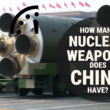Sustaining progress in nuclear security without the summits—an African view
By Hubert Foy, March 25, 2016
Some—the Russian government, for example—argue that the Nuclear Security Summits have exhausted their ability to mobilize the international community to secure nuclear materials. This argument is incorrect and dangerous. Nuclear and radiological terrorism continues to pose a threat and will do so for the foreseeable future. And though the summits have made good progress toward achieving their agenda, much unfinished business remains.
Across my home continent of Africa, for example, security measures are inadequate. In a number of nations, including some where terrorists operate, governance is patchy and regulation weak. Meanwhile, Africa is a continent where more than 20 nations have announced interest in establishing nuclear energy programs. South Africa, the only nation on the continent with nuclear power today, plans to expand its capacity. So—in one dedicated format or another—the summit process should continue beyond 2016.
Much to be proud of. The most significant accomplishment of the summit process has been a worldwide reduction in the number of sites hosting materials that could be used to make nuclear bombs. This reduction is crucial because, if all reactors used for research and isotope production were fueled with low-enriched uranium instead of highly enriched uranium (HEU), and all fresh and spent HEU fuel were taken back by supplier countries, terrorists seeking to carry out an attack with a crude, gun-type nuclear bomb would face much greater obstacles.
Africa has made an important contribution to eliminating civilian HEU and consolidating spent fuel. In 2010, South Africa finished converting its SAFARI-1 reactor—which produces molybdenum-99, the world's most important medical radioisotope—to low-enriched uranium. It was the first reactor worldwide to complete conversion and begin producing molybdenum-99 on a large scale. Additionally, 6.3 kilograms of US-origin spent HEU fuel were removed in 2011 from a South African research facility.
Another significant achievement for the summit process has been the support provided, at the national, bilateral, and multilateral levels, for education and training initiatives to develop human resources and build capacity. The International Atomic Energy Agency, for example, reported that in 2012 it had "conducted over 80 training events covering all aspects of nuclear security, involving more than 2,000 people." The United States in 2015 enabled more than 40 nuclear experts from developing countries—including Egypt, Morocco, Nigeria, and South Africa—to attend the annual meeting of the Institute of Nuclear Materials Management, where they learned about promoting a culture of nuclear security in their own countries. The training provided by programs such as these is vital to effective, sustainable nuclear security systems.
Finally, numerous states have joined nuclear terrorism conventions during the summit process. Ten African states, among many other nations, have ratified the 2005 amendment to the Convention on Physical Protection of Nuclear Material since the summits began. A number of African nations have also acceded to the International Convention on the Suppression of Acts of Nuclear Terrorism. By joining these conventions, African states demonstrate a regional commitment to strengthening the global nuclear security regime.
Much left undone. Despite these notable successes, the summits have failed to realize several goals. One unmet goal is to phase out highly enriched uranium as a fuel for research reactors where technically and economically feasible. In Africa, seven countries host a total of eight operational research reactors. Two of these eight—one in Ghana, one in Nigeria—are powered with highly enriched uranium. Conversion is in process at both facilities. When these conversions are complete, Africa will have eliminated highly enriched uranium in civilian nuclear applications and the world will be a step closer to freedom from nuclear terror.
Another remaining challenge, particularly in some developing countries, is that complacency sometimes surrounds the threat of nuclear terrorism. A majority of developing countries do not prioritize nuclear terrorism in their national security agendas. They can dedicate only limited human and financial resources to nuclear security. Indeed, many political leaders in Africa believe the probability that nuclear terrorism will occur on their territory is zero. In the global nuclear security system, nations such as these are weak links that terrorists might exploit. The 2007 intrusion incident at South Africa’s Pelindaba nuclear research facility exemplifies how creeping complacency can sap security, even in advanced nuclear states with decades of experience. Complacency must be curtailed before the global nuclear security system can be considered adequate.
A last piece of unfinished business is simply that nuclear terrorism remains a threat—not a Hollywood concoction, but something dangerous and real. As argued in a 2014 report published by the Project on Managing the Atom, terrorists have "the motive, means, and opportunity [to commit] a monstrous crime." As long as the world is home to both terrorists intent on large-scale destruction and materials needed to make nuclear weapons, the threat of nuclear terrorism will persist.
No time to stop. With the summit process coming to a close, how can unfinished business be addressed? The most compelling approach may be to transfer the summit process to security institutions such as the International Atomic Energy Agency and Interpol. Each agency, depending on its capabilities and drawing on its existing staff and framework, might tackle a specific set of nuclear security issues. Such an approach has the potential to engage all UN member countries, including non-summit participants, in strengthening nuclear security.
Another way to continue the process is through the creation or expansion of certain initiatives for nuclear security training and standards. In nuclear security, people are a crucial element—so skill, knowledge, and ability must be developed wherever people involved in nuclear security actually work. One way to advance this goal would be, at the 2016 summit, to agree that the WINS Academy, a training and certification initiative of the World Institute for Nuclear Security, should be fully operationalized. In any event, when all nations have access to common training programs and best practices, and share a common nuclear security culture, countries and organizations will have the personnel and tools to identify and redress vulnerabilities in their nuclear security architectures.
Finally, the summit process could in some sense be continued if countries at the 2016 summit agreed on ways to promote, at the regional and international levels, comprehensive intelligence sharing. Political leaders across the developing world would thus become aware of the real dangers associated with terrorism and nuclear materials—and would be more likely to promote strong nuclear security measures in their nations.
A second death toll. No incident of nuclear terrorism has ever occurred. But securing vulnerable nuclear material is a must—not least because, in a globalized economy, an attack on any city would, in the words of former UN Secretary-General Kofi Annan, push "tens of millions of people into dire poverty," creating a "second death toll throughout the developing world." Given the severe threat that nuclear terrorism poses, continuing the summit process in appropriate, dedicated formats is an investment that could pay for itself many times over.
Topics: Nuclear Energy, Nuclear Weapons
Share: [addthis tool="addthis_inline_share_toolbox"]














